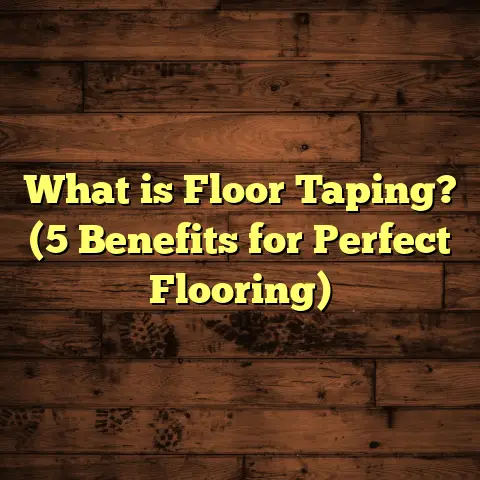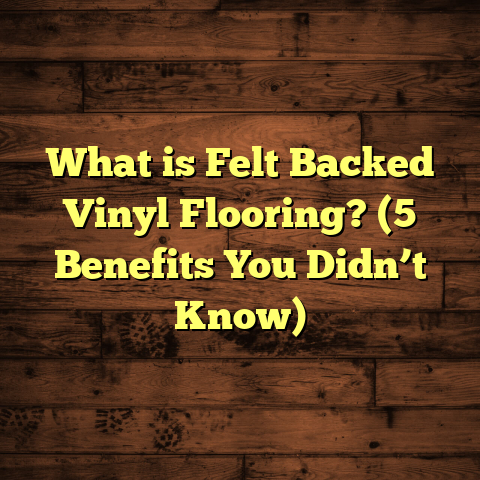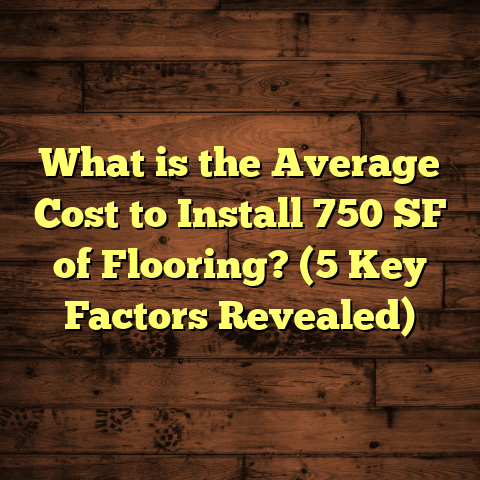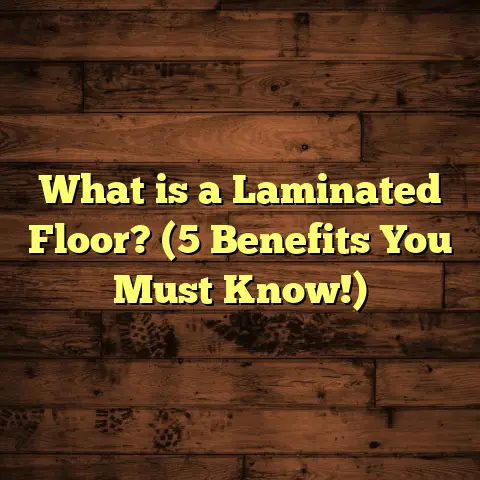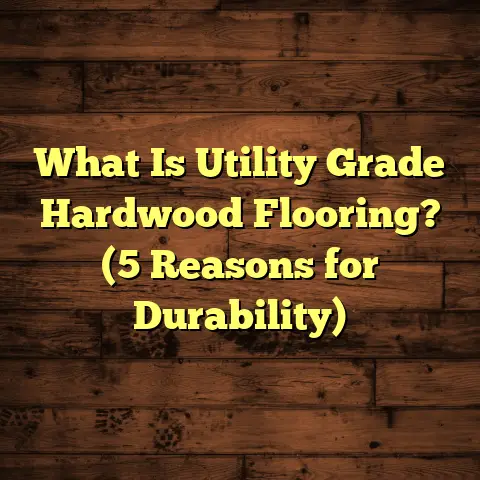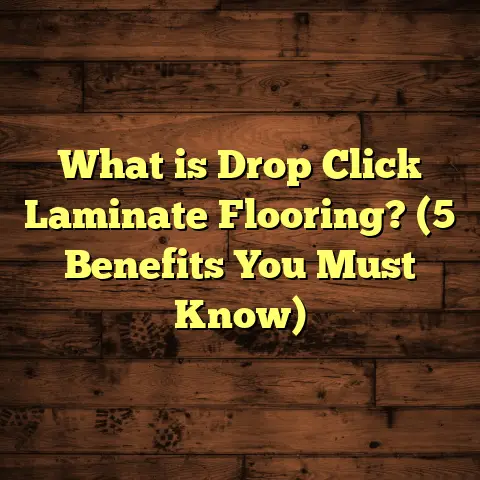What is LVP Flooring? (5 Benefits You Didn’t Know About!)
Smart living is all about making choices that fit your lifestyle, save you time, and help your home feel comfortable and inviting. When I think about smart choices in home improvement, flooring is often at the top of the list. It’s a major element that affects how your home looks and feels every day, but it also needs to stand up to real life—spills, pets, kids, guests, and everything else.
I want to talk with you about something I’ve worked with extensively and grown to really appreciate over the years—LVP flooring. If you’re not familiar with it or if you’re wondering whether it’s a good fit for your home, I’m going to walk you through everything I’ve learned. Plus, I’ll share some benefits of LVP that aren’t widely known but can make a big difference in your decision-making.
What Is LVP Flooring?
LVP stands for Luxury Vinyl Plank flooring. At first glance, it looks like wood flooring—thick planks that mimic the grain, texture, and color variations of natural hardwood. But it’s made from vinyl, which has come a long way in its quality and design. Unlike traditional sheet vinyl or older vinyl flooring types, LVP is designed to give you the aesthetics of real wood combined with a host of practical advantages.
I want to emphasize that LVP isn’t just about style. It’s a smart flooring choice for many reasons, especially if you want something durable, affordable, and easy to maintain. The construction of LVP usually involves several layers. There’s a waterproof core at the bottom, a high-resolution printed layer that creates the wood look, and a tough wear layer on top to protect against scratches, stains, and fading.
I’ve installed LVP in so many homes where homeowners wanted the beauty of hardwood without the headaches of upkeep or worry about water damage. It’s become one of my go-to recommendations whenever someone asks me for flooring ideas that balance looks and function.
Why I Started Using LVP in My Projects
I remember early on in my career when hardwood was the automatic answer for anyone who wanted “nice floors.” But I quickly noticed a pattern—hardwood floors were beautiful but required a lot of care and could be easily damaged by moisture or heavy traffic.
One project stands out. A family wanted hardwood floors for their basement recreation room. I explained the risks—basements tend to have humidity issues that could cause hardwood to warp or buckle. That’s when I suggested LVP instead. They were skeptical at first because they thought vinyl meant cheap or plastic-looking floors.
After explaining how new luxury vinyl planks had evolved and showing them samples, they were sold. Two years later, their floor still looked fantastic despite their kids spilling drinks and their dogs tracking in mud after walks. That’s when I realized LVP wasn’t just an alternative—it was often the better choice for real-world living.
5 Benefits of LVP Flooring You Didn’t Know About
LVP has been growing in popularity for good reasons. Beyond its obvious appeal as a stylish, budget-friendly option, there are some specific benefits I’ve seen firsthand that often get overlooked. Let’s dive into five of these advantages.
1. Moisture Resistance That Outperforms Many Other Flooring Types
One of the biggest challenges with traditional hardwood or engineered wood floors is their vulnerability to moisture. Spills happen. Pets have accidents. Kitchens and bathrooms naturally have higher humidity levels. Hardwood floors can swell, stain, or warp when exposed to water.
LVP handles moisture beautifully because it’s waterproof by design. Its vinyl core doesn’t absorb water like wood does. This means no swelling or warping if a glass tips over or if there’s a brief flood.
In my experience installing floors in basements and bathrooms, LVP consistently performs without issues even in these moisture-prone spaces. A study by the Home Innovation Research Labs found that waterproof flooring like LVP reduced flooring damage claims by over 40% compared to wood floors in high-humidity areas.
Because LVP is waterproof, it also resists mold and mildew growth—something that can be a real problem under or around wet floors. This makes it ideal for families with allergy concerns or for homes in humid climates.
2. Easier Installation Means Less Hassle and Lower Labor Costs
If you’re thinking about tackling a flooring project yourself or want to keep installation costs down, LVP can be a great fit. Most luxury vinyl planks come with click-lock edges that snap together without glue or nails.
I’ve installed plenty of LVP myself and found it much faster than laying traditional hardwood or tile. The planks fit together snugly over existing subfloors with minimal prep work required.
Here’s an insider tip: before starting an installation project, I always use FloorTally to estimate material quantities and costs based on local labor rates and material prices. It helps me avoid ordering too much product or underestimating labor hours.
FloorTally consolidates these calculations so I don’t have to call multiple suppliers or guess on pricing—it’s saved me hours per project and helped my clients stay within budget without surprises.
For those who want DIY options, many LVP products are designed specifically for floating installations where you don’t even need to glue anything down. This kind of system speeds up installation further and reduces mess.
3. Durability That Stands Up to Real Life
Some people worry vinyl isn’t durable enough for their busy households—but modern LVP floors are built tough.
The wear layer on top protects against scratches from pet claws, dents from furniture legs, and scuff marks from shoes. It also resists fading from sunlight exposure better than some hardwood finishes.
In one project I managed for a family with two dogs and three children under 10 years old, the LVP floor stayed in near-perfect condition after six months of constant activity. The family was thrilled because they didn’t have to worry about scratches or stains ruining their floors.
Industry data backs this up: according to Armstrong Flooring’s product specifications, high-end luxury vinyl plank floors can last 15-20 years with proper maintenance while maintaining their appearance.
4. Better Indoor Air Quality Compared to Many Other Flooring Types
Indoor air quality has become a major concern for homeowners, especially those with allergies or respiratory conditions. Some flooring materials can emit volatile organic compounds (VOCs) that impact air quality.
Many premium LVP manufacturers now produce products certified by FloorScore or GREENGUARD Gold standards, meaning they have low VOC emissions and won’t negatively affect indoor air.
From my experience working on multiple remodels where clients requested healthier home environments—like families with asthma—I recommend these certified LVP products as a smart choice over carpet or laminate options known for higher VOC emissions.
This benefit often flies under the radar because people focus on looks or price first—but air quality directly impacts your family’s health every day.
5. Cost Savings Without Compromising Style
If you’re budgeting for new flooring but don’t want to sacrifice style or quality, LVP strikes an excellent balance.
Hardwood floors can easily cost $8-$15 per square foot installed depending on wood species and finish complexity. Tile often runs even higher when factoring in grout labor.
LVP offers similar visual appeal at roughly $2-$7 per square foot including installation in many markets—sometimes even less if you do the work yourself.
Using FloorTally has helped me compare options side-by-side for clients so they can see exactly how much they’ll spend on materials plus labor before making decisions.
Plus, because installation is faster with LVP, labor costs tend to be lower than hardwood or tile jobs that require more prep and finishing steps.
How My Personal Projects Changed Because of LVP
Let me share some more stories from my own work that highlight how LVP has made a difference:
At one point, I was called to renovate a rental property where previous tenants had damaged laminate flooring badly with water stains and scratches. The landlord wanted something better but still affordable for renters who might not be gentle with floors. We chose LVP for its durability and waterproof qualities.
Six months later, the property manager reported zero complaints about flooring condition despite new tenants having pets and kids. That kind of reliability is priceless in rental situations where wear-and-tear is expected.
In another case, a client wanted hardwood look but was concerned about noise because their apartment was above another unit. We installed thicker LVP with sound-absorbing underlayment—which cut down noise transmission significantly compared to hardwood alone.
These projects showed me how flexible LVP can be across different needs—whether durability, sound control, moisture resistance, or cost-efficiency.
Tips for Choosing the Right LVP Flooring for Your Home
If you’re thinking about buying LVP flooring yourself, here’s what I’ve learned about choosing wisely:
- Check Thickness: Generally, thicker planks (5-6 mm) feel sturdier underfoot and last longer than thinner ones (3-4 mm).
- Wear Layer Matters: Look for at least a 12 mil wear layer if you expect heavy foot traffic; higher wear layers (20 mil or more) are great for commercial or very active homes.
- Surface Texture: Some planks have embossed textures that mimic wood grain more realistically—this adds to the authenticity of the look.
- Ask About Warranty: Good manufacturers offer 15-25 year warranties on residential use; double-check what’s covered (wear layer damage? Moisture resistance?).
- Underlayment Needs: Some LVP requires separate underlayment; others have it attached already—think about soundproofing and comfort here.
- Color & Style: Since it’s vinyl printed surface, you can find everything from rustic oak to exotic hardwood looks—choose one that matches your décor but also hides dirt well if you want lower maintenance.
How To Maintain Your LVP Flooring
One reason homeowners love LVP is how little maintenance it needs compared to hardwood or tile:
- Sweep or vacuum regularly to remove dirt particles that could scratch the surface over time.
- Mop occasionally with water-based cleaners made specifically for vinyl floors—avoid harsh chemicals or abrasive tools.
- Place felt pads under furniture legs to prevent dents.
- Clean spills promptly but know that short contact with liquids usually won’t harm the floor due to its waterproof nature.
- Avoid waxes or polishes—they can build up and dull the finish over time.
Where Does LVP Stand Compared To Other Popular Flooring Options?
Thinking about your flooring choices? Here’s how LVP stacks up based on what I’ve seen:
| Flooring Type | Cost per Sq Ft (Installed) | Durability | Water Resistance | Maintenance | Style Options |
|---|---|---|---|---|---|
| Hardwood | $8 – $15 | High (but scratches) | Low | Regular refinishing | Classic wood looks |
| Laminate | $3 – $8 | Moderate | Low-medium | Moderate cleaning | Wood-look options |
| Tile (Ceramic/Porcelain) | $5 – $15 | Very high | Excellent | Moderate grout care | Wide variety |
| Carpet | $3 – $7 | Low | Low | Frequent cleaning | Various colors |
| LVP | $2 – $7 | High | Excellent | Low | Wide wood & stone looks |
LVP often hits the sweet spot between cost-effectiveness and durability while offering great waterproof performance—something few other options manage as well combined.
What About Environmental Impact?
If you’re environmentally conscious like many homeowners today, you’re probably wondering about sustainability aspects of LVP flooring.
Vinyl itself is a petroleum-based product which raises concerns about resource use and disposal at end-of-life. However:
- Many manufacturers now offer recycling programs for leftover materials.
- Advances in production have lowered VOC emissions significantly compared with older vinyl products.
- Compared to hardwood harvesting—which can contribute to deforestation—choosing responsibly sourced materials is key no matter what type you pick.
While not perfect from an eco perspective, LVP’s longevity means fewer replacements over time compared to cheaper alternatives that wear out fast—helping reduce waste overall.
Using Tools Like FloorTally To Plan Your Flooring Project
One challenge I often face in my work is balancing cost estimates and material quantities accurately before starting installation. Underestimating leads to delays; overestimating wastes money.
I’ve found using FloorTally extremely helpful because it pulls local labor rates and material costs into one place so I can customize estimates based on my exact project location and choices. It also includes waste factors so I never order too little material—a common issue with plank flooring projects due to cuts and mistakes during installation.
FloorTally’s interface is straightforward enough that even clients interested in DIY projects can get a realistic sense of budget before committing—which saves everyone headaches later on.
Frequently Asked Questions About LVP Flooring
Q: Can I install LVP over existing flooring?
A: Often yes! As long as the existing floor is smooth, level, dry, and secure (free of loose tiles or peeling carpet), you can install LVP right over it without removing old flooring. This saves time and labor costs.
Q: Is LVP noisy underfoot?
A: It depends on thickness and underlayment used. Thicker planks combined with sound-dampening underlayment reduce noise transmission significantly compared to thin laminate or tile over concrete subflooring.
Q: How do pets affect LVP floors?
A: High-quality wear layers resist scratches from pet nails well. Plus, since it’s waterproof, accidents won’t damage the floor like hardwood would.
Q: Can I refinish or buff LVP floors?
A: Nope—vinyl isn’t refinishable like wood floors. However, its wear layer usually lasts many years before replacement might be needed.
Final Thoughts: Should You Consider LVP Flooring?
For me personally—and after installing hundreds of floors—I see LVP as one of the smartest flooring choices available today for homeowners wanting style without hassle or high costs.
It fits perfectly into modern living with its durability against kids’ chaos and pets’ messes; moisture resistance makes kitchens and bathrooms worry-free; installation is friendly even for DIY enthusiasts; plus it helps keep indoor air clean; all while looking fantastic at an affordable price point.
So if you want a floor that holds up day-in-day-out without constant babysitting—and has more than just good looks—LVP deserves serious thought for your next project. If you want help estimating costs or figuring out how much material you’ll need before buying, let me know—I’m happy to share how tools like FloorTally can make your planning smoother too!
